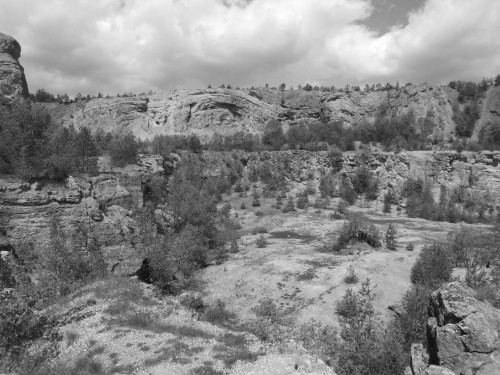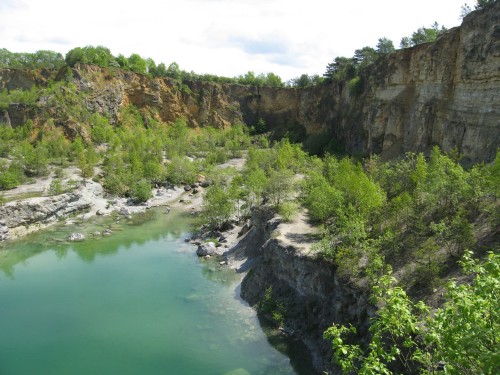
Im Steinbruch Ludwag II wird seit vielen Jahren nicht mehr abgebaut und befinden sich im Bereich der Fränkischen Alb, etwa 20 km östlich von Bamberg. Der See im tiefsten Bereich des Steinbruchs wird von den Einheimischen als Badegelegenheit genutzt, was an heißen Sommertagen sicherlich auch für Geocacher angenehm sein kann. 
Im oberen Jura (Kimmeridgium), also vor rund 140 Millionen Jahren, erstreckte sich über weite Teile Europas ein ausgedehntes Schelfmeer, in denen zahlreiche Inseln gute Bedingungen für ein Wachstum von mittelgroßen Riffen aus Schwämmen und Algen boten.
Gleich wenn man vom Parkplatz in den Steinbruch hinabsteigt kommt man einer Besonderheit vorbei. Hier im fast schwarzen harten Dolomit sind Fossilien enthalten - das gibt es nur ganz selten! Dolomitisierte Fossilien sind auf wenige Lokaliäten beschränkt.
Die große Attraktion des alten Steinbruchs ist eine geologisch-paläontologische Erscheinung in der Nordwand. Die hier großräumig auf eine Länge von rund 200 m angeschnittenen Schwammriffkuppeln stellen das schönste derartige Beispiel der Frankenalb dar. Allein diese Wand rechtfertigt schon den Besuch der Lokalität (beste Lichtverhältnisse am Spätnachmittag).
Im Steinbruch kann überall nach Fossilien gesucht werden. Besonders für Kinder ist ein Besuch lohnenswert. Zum Suchen sollte man entsprechende Ausrüstung mitbringen. Hier eine kleine Auswahl: Eimer, Hammer (Maurerhammer), Schutzbrille
Achtung: Von den Steilwänden unten wie oben fernbleiben!
Die hohe rechts des Weges in die tieferen Steinbruchbereiche aufsteigende Steilwand ist sehr instabil - keinesfalls hier zum Sammeln verweilen!
Der Earthcache:
Um diesen Earthcache zu loggen, musst du ein Bilder zu deinem Log hochladen und eine Email verschicken.
1. Ein Foto mit einer gefundenen Fossilie. Das sollte dir hier in diesem Steinbruch recht einfach gelingen, eine gute Ecke ist in der Nähe des Sees.
2. Welche 2 Haupt-Farben sind bei dem Schwammriffkomplex zu sehen?
An der Listingkoordinate, Blickrichtung Nord (von oben nach unten, mögliche Farben: grau, blau, rot, gruen) Schicke mir eine Email oder eine Message zur Logfreigabe an mein Profil.
In der Email solltet ihr nur euren Account-Namen schreiben. Ihr dürft sofort loggen, falls etwas nicht stimmt melde ich mich.
Das Bild sollt ihr dem Log beifügen.
In upper jurrasic period (Kimmeridgium), approximately 140 millionyears ago, an expanded shelf sea extended over far parts of Europe, in which numerous islands offered good conditions for a growth of medium sized reefs from sponges and algae.
Equal if one of the parking lot into the quarry descends goes past one a characteristic. Here in the nearly black hard dolomite fossils are contained - it gives only completely rarely! Dolomitest fossils are limited to few locations.
The large attraction of the old quarry is a geological paläontological feature in the north wall. Here spaciously the sponge reef domes were cut on a length of approximately 200 m represent the most beautiful such example of the Frankenalb. However this wall justifies already the visit of the location (best lighting conditions in the late afternoon).
In the quarry can be searched everywhere for fossils. Particularly for children a visit is be worth worth. For looking for fossils you should bring appropriate equipment. Here a small selection: Bucket, hammer (bricklayer hammer), eye protector
Attention: Be aware of the steep walls!
The high steep walls besides the way into the deeper quarry ranges is very unstable - do not stay for collecting under any circumstances close to the walls!
The Earthcache:
In order to log this Earthcache, you must upload one picture to your log and send an email:
1. A photo with a found fossil. That should succeed to you here in this quarry quite simply, a good location is in the proximity of the lake.
2. Which two colours can be seen at the sponge reef complex? (Go to the listing coordinates and look into north direction.) (from up to down, possible colours en=de: grey=grau, blue=blau, red=rot, green=gruen) Send an email with your account name to my email or message me. You can log direct after. If somthing is wrong i will ask you.
Please add your picture to your log.